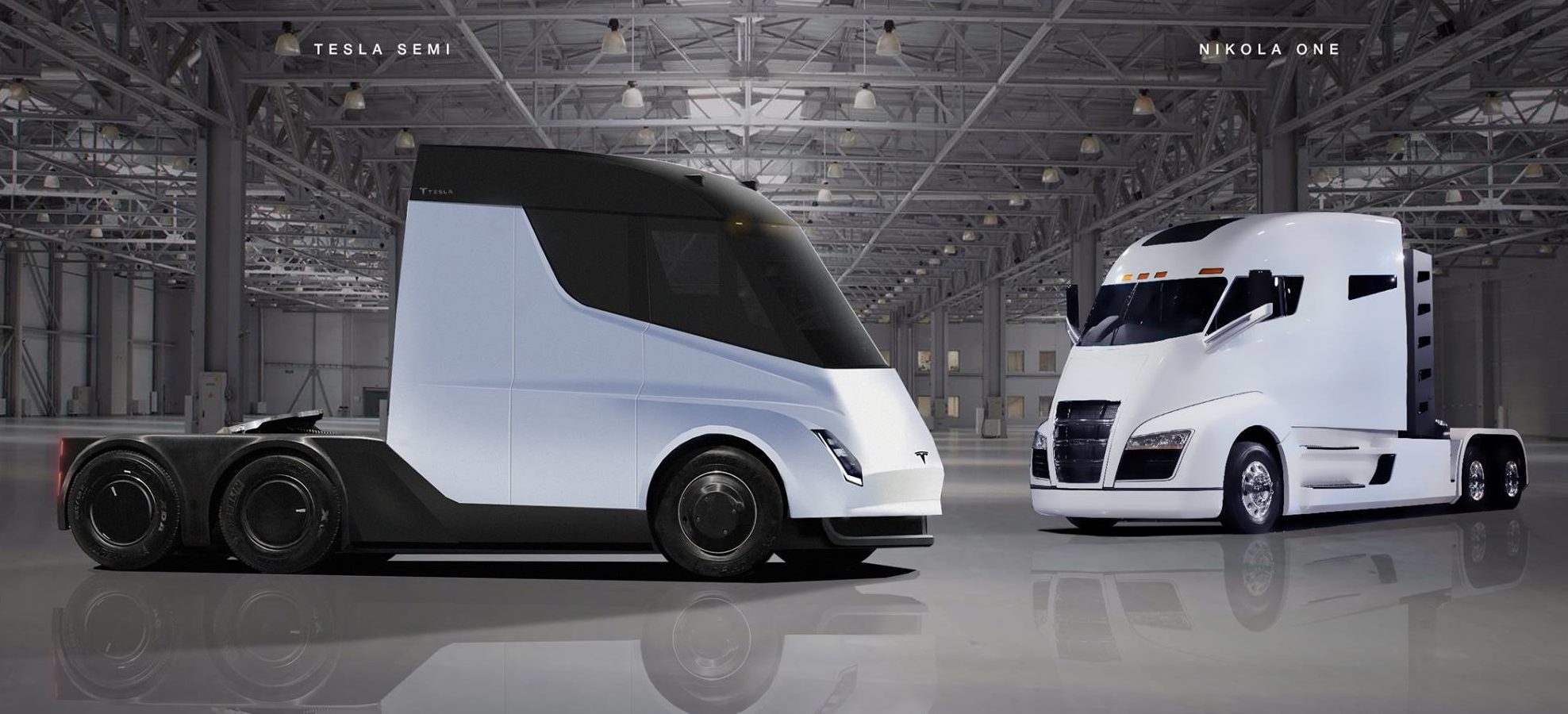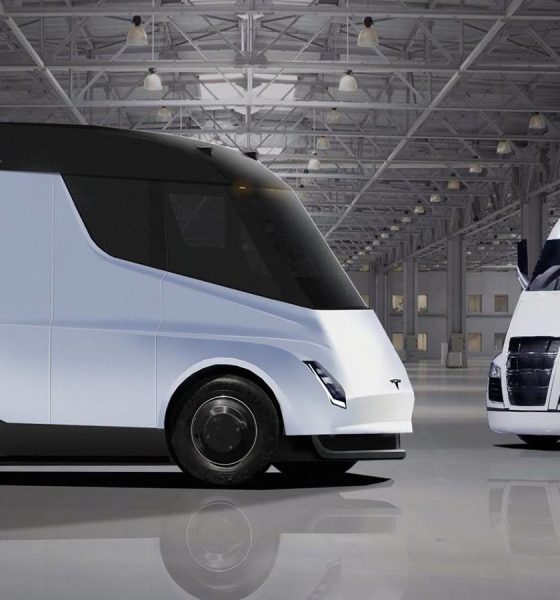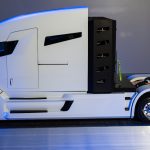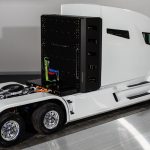

News
Tesla Semi rival Nikola dubs future fleet as US’ ‘largest air purifiers’ amid hiring ramp
As the Tesla Semi continues to undergo real-world testing in preparation for its initial production in 2019, rival startup company Nikola Motor has claimed that its future fleet will be the United States’ “largest air purifiers,” thanks to their hydrogen fuel cell systems. Nikola’s announcement comes amidst the company’s current initiatives to ramp its hiring activities for its facilities in Arizona.
No stranger to bold declarations on Twitter, Nikola noted that due to its vehicles’ hydrogen fuel cell system, its fleet of trucks would be able to clean the air as they drive across America. In a later tweet, the trucking startup also assured its social media followers that it does not use methane to produce hydrogen. Rather, it utilizes a combination of solar, wind, and hydropower to make the hydrogen needed to power its upcoming fleet.
Why do we like hydrogen so much? The Nikola fleet will be one of the largest air purifiers in America one day. Imagine 500,000 Nikola trucks driving in cities across America sucking in dirty air and emitting nothing but clean water. #emissionsgameover #dieselisdead
— Nikola Corporation (@nikolamotor) October 24, 2018
A following tweet from the company also gave a first look at the fuel cell that would be used for the Nikola One sleeper semi-trailer, as well as the Nikola Two daycab. The trucking startup and budding Tesla Semi rival further noted that a Nikola truck would have two 120 kW systems, which should provide its trucks with a considerable degree of power.
What an awesome Nikola fuel cell. This is the 120kW running through tests. Each truck has 2 X 120 KW systems. Get ready for some big news coming in the following days as promised. This thing rocks and we can't wait for the world to see it in action. pic.twitter.com/rLKx8oF8pM
— Nikola Corporation (@nikolamotor) October 29, 2018
Recent reports have further revealed that Nikola is starting to ramp its hiring as it prepares to start producing its highly-anticipated hydrogen-electric truck. Since moving to the Phoenix area from Utah in July, the company has employed about 70 people in Chandler as it constructs its new headquarters in Phoenix. By the end of the year, Nikola aims to have 100 employees, and by the end of 2019, the trucking startup is seeking to employ about 200 workers.
Nikola Motor chief legal officer Britton Worthen noted in a statement to AZ Central that it expects to break ground on its planned 1 million-square-foot manufacturing plant in Coolidge, AZ, in about two years. At a talk on Friday, the Nikola executive pointed out to Pinal County economic development officials that the upcoming facility would be complete in about five years. Over this time, Nikola also plans to start the expansion of its hydrogen fueling stations, which the company expects will be the ‘largest energy consumer’ in the US within the next ten years.
Nikola Motors is no stranger to bold statements. Earlier this year, the company announced that it would be refunding all the reservations it received for the Nikola One and Nikola Two. Seemingly throwing shade at Tesla, the trucking startup further noted that it does not “use (customers’) money to operate (its) business.” Nikola has declared that it currently has $11 billion in pre-production orders as well.
- The Nikola One
- The Nikola One.
- Credit: Nikola Motor
The Nikola One hydrogen-electric truck.
Over the past few months, though, Nikola started to adopt a more aggressive stance against Tesla. Earlier this year, the company filed a $2 billion lawsuit against the electric car maker, claiming that the Tesla Semi violated its design patents for the Nikola One. In its lawsuit, the trucking startup alleged that the Tesla Semi copied the Nikola One’s wraparound windshield, mid-entry door, front fenders, and the electric truck’s aerodynamic body. Furthermore, the trucking startup claimed that the similar designs of the Semi and the One puts its reputation at risk, since Tesla has had “problems with its batteries starting fires and its autonomous features causing fatal accidents.”
Nikola’s patent lawsuit met a notable roadblock in August, though, as the US Patent Office granted Tesla its own design patents for the Tesla Semi, with the US patent examiner even using the Nikola One as a comparison point for the all-electric long-hauler. Thus, if Nikola chooses to pursue its case against Tesla, it would have to prove that the US patent examiner made a mistake. Such a feat is very challenging to accomplish.
Its legal moves against Tesla aside, Nikola is nonetheless setting the stage of a grand, three-day event in April 2019, which would feature the unveiling of the pre-production models of its hydrogen-electric trucks. A 2.3-megawatt hydrogen fueling station, which would serve as a model for the company’s upcoming network of H2 refilling stations, is also expected to be unveiled.

News
Tesla FSD fleet is nearing 7 billion total miles, including 2.5 billion city miles
As can be seen on Tesla’s official FSD webpage, vehicles equipped with the system have now navigated over 6.99 billion miles.

Tesla’s Full Self-Driving (Supervised) fleet is closing in on almost 7 billion total miles driven, as per data posted by the company on its official FSD webpage.
These figures hint at the massive scale of data fueling Tesla’s rapid FSD improvements, which have been quite notable as of late.
FSD mileage milestones
As can be seen on Tesla’s official FSD webpage, vehicles equipped with the system have now navigated over 6.99 billion miles. Tesla owner and avid FSD tester Whole Mars Catalog also shared a screenshot indicating that from the nearly 7 billion miles traveled by the FSD fleet, more than 2.5 billion miles were driven inside cities.
City miles are particularly valuable for complex urban scenarios like unprotected turns, pedestrian interactions, and traffic lights. This is also the difference-maker for FSD, as only complex solutions, such as Waymo’s self-driving taxis, operate similarly on inner-city streets. And even then, incidents such as the San Francisco blackouts have proven challenging for sensor-rich vehicles like Waymos.
Tesla’s data edge
Tesla has a number of advantages in the autonomous vehicle sector, one of which is the size of its fleet and the number of vehicles training FSD on real-world roads. Tesla’s nearly 7 billion FSD miles then allow the company to roll out updates that make its vehicles behave like they are being driven by experienced drivers, even if they are operating on their own.
So notable are Tesla’s improvements to FSD that NVIDIA Director of Robotics Jim Fan, after experiencing FSD v14, noted that the system is the first AI that passes what he described as a “Physical Turing Test.”
“Despite knowing exactly how robot learning works, I still find it magical watching the steering wheel turn by itself. First it feels surreal, next it becomes routine. Then, like the smartphone, taking it away actively hurts. This is how humanity gets rewired and glued to god-like technologies,” Fan wrote in a post on X.
News
Tesla starts showing how FSD will change lives in Europe
Local officials tested the system on narrow country roads and were impressed by FSD’s smooth, human-like driving, with some calling the service a game-changer for everyday life in areas that are far from urban centers.

Tesla has launched Europe’s first public shuttle service using Full Self-Driving (Supervised) in the rural Eifelkreis Bitburg-Prüm region of Germany, demonstrating how the technology can restore independence and mobility for people who struggle with limited transport options.
Local officials tested the system on narrow country roads and were impressed by FSD’s smooth, human-like driving, with some calling the service a game-changer for everyday life in areas that are far from urban centers.
Officials see real impact on rural residents
Arzfeld Mayor Johannes Kuhl and District Administrator Andreas Kruppert personally tested the Tesla shuttle service. This allowed them to see just how well FSD navigated winding lanes and rural roads confidently. Kruppert said, “Autonomous driving sounds like science fiction to many, but we simply see here that it works totally well in rural regions too.” Kuhl, for his part, also noted that FSD “feels like a very experienced driver.”
The pilot complements the area’s “Citizen Bus” program, which provides on-demand rides for elderly residents who can no longer drive themselves. Tesla Europe shared a video of a demonstration of the service, highlighting how FSD gives people their freedom back, even in places where public transport is not as prevalent.
What the Ministry for Economic Affairs and Transport says
Rhineland-Palatinate’s Minister Daniela Schmitt supported the project, praising the collaboration that made this “first of its kind in Europe” possible. As per the ministry, the rural rollout for the service shows FSD’s potential beyond major cities, and it delivers tangible benefits like grocery runs, doctor visits, and social connections for isolated residents.
“Reliable and flexible mobility is especially vital in rural areas. With the launch of a shuttle service using self-driving vehicles (FSD supervised) by Tesla in the Eifelkreis Bitburg-Prüm, an innovative pilot project is now getting underway that complements local community bus services. It is the first project of its kind in Europe.
“The result is a real gain for rural mobility: greater accessibility, more flexibility and tangible benefits for everyday life. A strong signal for innovation, cooperation and future-oriented mobility beyond urban centers,” the ministry wrote in a LinkedIn post.
News
Tesla China quietly posts Robotaxi-related job listing
Tesla China is currently seeking a Low Voltage Electrical Engineer to work on circuit board design for the company’s autonomous vehicles.

Tesla has posted a new job listing in Shanghai explicitly tied to its Robotaxi program, fueling speculation that the company is preparing to launch its dedicated autonomous ride-hailing service in China.
As noted in the listing, Tesla China is currently seeking a Low Voltage Electrical Engineer to work on circuit board design for the company’s autonomous vehicles.
Robotaxi-specific role
The listing, which was shared on social media platform X by industry watcher @tslaming, suggested that Tesla China is looking to fill the role urgently. The job listing itself specifically mentions that the person hired for the role will be working on the Low Voltage Hardware team, which would design the circuit boards that would serve as the nervous system of the Robotaxi.
Key tasks for the role, as indicated in the job listing, include collaboration with PCB layout, firmware, mechanical, program management, and validation teams, among other responsibilities. The role is based in Shanghai.
China Robotaxi launch
China represents a massive potential market for robotaxis, with its dense urban centers and supportive policies in select cities. Tesla has limited permission to roll out FSD in the country, though despite this, its vehicles have been hailed as among the best in the market when it comes to autonomous features. So far, at least, it appears that China supports Tesla’s FSD and Robotaxi rollout.
This was hinted at in November, when Tesla brought the Cybercab to the 8th China International Import Expo (CIIE) in Shanghai, marking the first time that the autonomous two-seater was brought to the Asia-Pacific region. The vehicle, despite not having a release date in China, received a significant amount of interest among the event’s attendees.











